Today’s feature is from our companion service, Airgun Wire.

You can always recognize an AirForce Airgun from a couple of miles away. That distinctive “Space Force” shape isn’t just for Sci-Fi cosmetic appeal – the company’s iconic use of the air reservoir tank as the buttstock is also an efficient use of space and weight. If you have to have something on which to rest your face, it might as well be useful, right? I also have to think that the “air tank behind the chamber” design is more efficient as the high-pressure breeze follows a straight shot to push the pellet out the perforated end. For rifles with air reservoirs up front, all that air has to make a complete U-turn to move forward. I’m not sure there’s any science on that, but it sounds logical, so that’s my story and I’m sticking to it.

You’ve got to love the “Space Force” appearance of AirForce’s rifles. I do.
The AirForce Condor SS is an integrally suppressed air rifle with a shroud along the entire length of the 18-inch barrel. That design not only keeps things quiet for backyard applications but also results in a compact overall length of just 38 1/8 inches. The Lothar Walther barrels are available in .177, .20, .22, and .25 calibers and you can order the Condor SS in black, blue, or red.
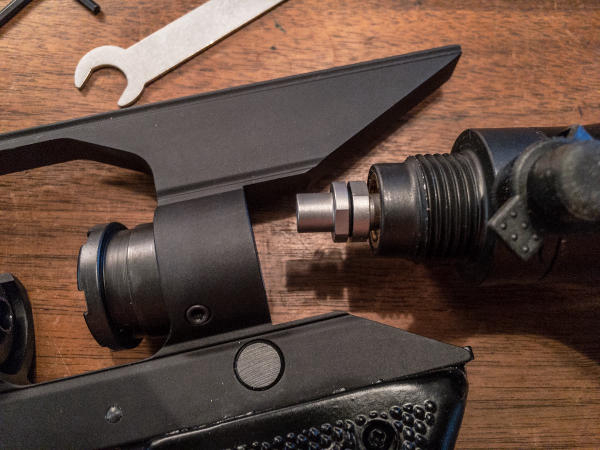
That iconic air reservoir that doubles as a stock is removable, so feel free to stick a pre-charged spare in your pack or range bag.
Now back to that air reservoir stock… The gas bottle is easy to swap so you can tote along a pre-filled spare and change it out when your air supply runs low. The standard tank holds 490 ccs of air compressed to 3,000 pounds per square inch. The 3K pressure limit dramatically expands your fill options as you can get that amount of pressure from most any dive shop. Rifles with 4,500 psi tanks require a little more shopping to find an air source.
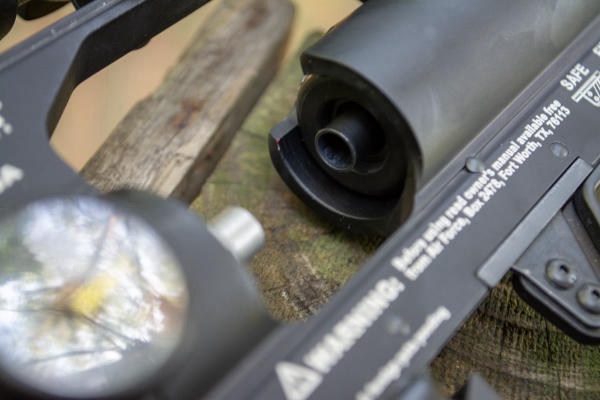
The Condor SS is a single-shot bolt-action. Load one pellet at a time directly into the breech.
The Condor SS features a single-shot action driven by a topside bolt charging handle. To cock the Condor, move the lever back to center from the right or left locked position and push forward until you hear a click. Next, draw the handle back and lock it to either side. The ambidextrous bolt latch is a nice touch that makes the action friendly for right and left-handers. When the bolt is open, you insert a pellet directly into the breech. Be sure to seat it fully for best results.
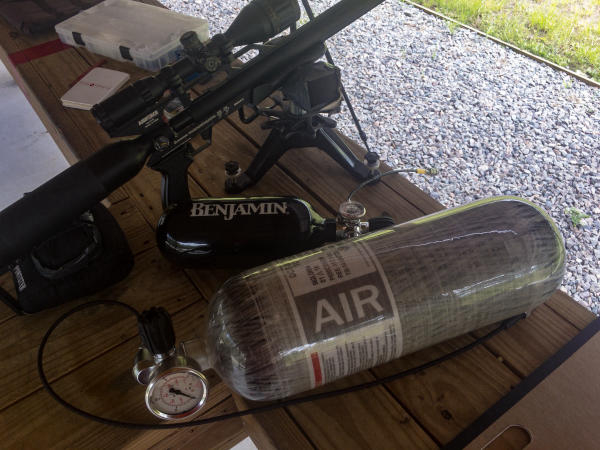
To ensure unlimited shooting while testing the Condor, I brought along a full-size tank from Omega Air Cylinders and a more portable Benjamin 15-inch cylinder.
The sample rifle shown here came equipped with an AirForce 3-9×50 scope. Adjustable for parallax down to just five yards, it was an excellent pairing for the .25 Condor SS. The mil-dot reticle is illuminated in red, green, or blue, so it’s suitable for pest control applications during the dusk hours.
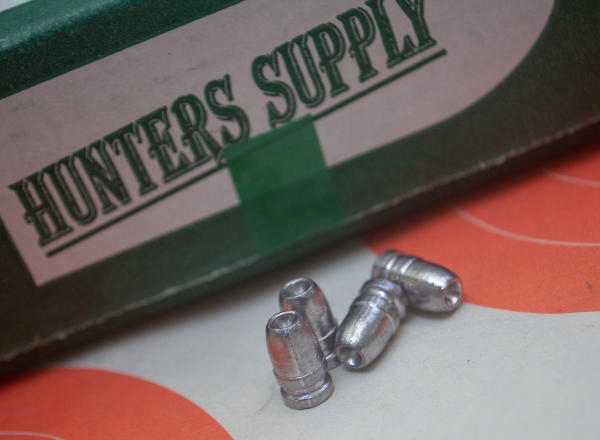
“I shall call them… mini-slugs.” These are the 48-grain hollow-point .25 caliber slugs from Hunters Supply.
I’ve been shooting the Condor with two different traditional pellets, plus a little something different from the folks at Hunters Supply.
The JSB Exact King pellets carry the traditional Diabolo shape with a skirted base and round head. They weigh 25.39 grains. Over different shooting outings, they performed well from 25 yards in windy conditions. Five-shot groups measured .42 and .27 inches on one outing and a quick group fired on a different day printed a .70-inch five-shot cluster. That averages out to .46 inches. I’ll take that.
Wind or not, I decided to stretch things out and move the targets to 50 yards. To factor out the wind impact, I waited for pauses in the breeze before firing each shot. That tested my patience. The Condor is a fun rifle to shoot and sitting around waiting on air to calm the heck down was about as much fun as counting to 100 before eating the second Reese’s Peanut Butter Cup. Perseverance and patience paid off as I managed to print groups averaging .94 inches from the 50-yard mark. Since that worked out pretty well, I moved the targets to 100 yards. Why not, right? The wind got me here as my five-shot group opened up to 3.04 inches. How did I know it was wind? The horizontal spread was 3.04 inches. The vertical spread was only .50 inches. That’s impressive.
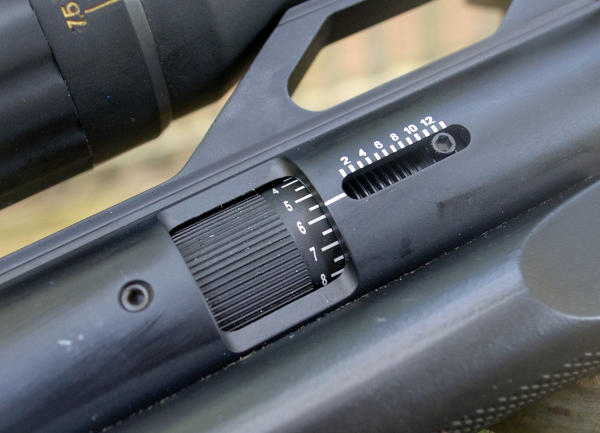
The power dial is easily adjustable on a per-shot basis and allows you to optimize for power or number of shots per fill. I also suspect that careful testing will help you find the optimal accuracy setting per pellet type and weight.
I also checked out accuracy performance with the H&N Sport Barracuda Hunter. Also a traditional air pellet design, these tip the scales at 27.47 grains each—a tad more portly than the JSBs. My 25-yard five-shot groups came in at an average of .46 inches. As you may remember that’s the exact number as the JSB Exact pellets. That was an interesting coincidence, so I have to wonder if I’ve just uncovered a secret, industry-wide conspiracy. I’m guessing that the same company that manufactures all brands of anti-freeze also makes the world’s supply of airgun pellets. If such an outlandish theory ever turns out to be true, remember that you heard it here first. From 50 yards, things spread out to 1.875 inches on average. I shot these on the same day as the JSB Exact pellets, so I’m not sure why the 50-yard groups opened up more with the H&N’s. Range gremlins no doubt.
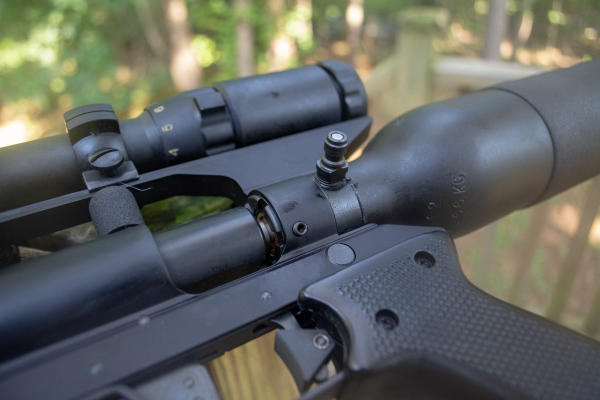
While the air reservoir is removable, you can fill it in place via the Foster connection.
And now for something completely different from Hunters Supply. Besides making billions of lead projectiles for center-fire and air arms, they have a portion of the business dedicated to AirForce airgun customization, so they know a thing or two about AirForce air rifles. The two loads they sent both resemble big bore lead slugs, but smaller. I shall call them mini-slugs. One is a 49-grain flat point, and the other is a 48-grain hollow point version of the same design. Guess what we can deduce from that? Right. A hole in the front weighs precisely one grain. I tested these heavies at 25 yards for accuracy. The flat points printed five-shot groups averaging 1.04 inches. The hollow point mini slugs grouped into 1.30 inches. I ran out of range time while working with these, so stay tuned. I’m going to get into more detailed testing with the Air Force Condor SS and these mini slugs in a future column, mainly because they’re just cool. As a side note, the Hunters Supply mini-slugs were tight in the chamber, and it took some muscle to seat them fully. That’s just something to know of as you’ll get best results with a fully seated pellet.
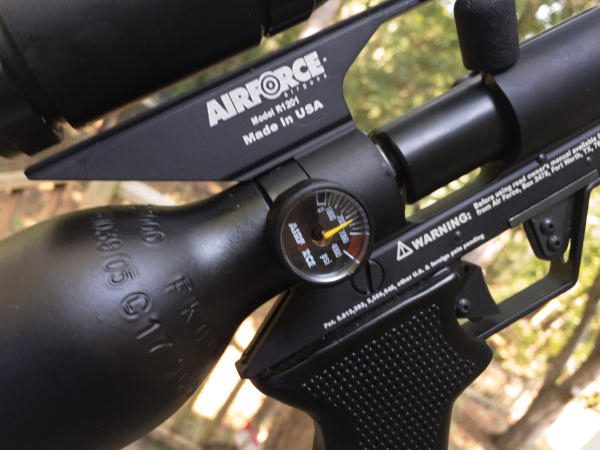
The manometer is located directly opposite the fill port and allows you to monitor remaining charge.
Since the Condor was happy enough digesting the JSBs, I did a little velocity testing while checking out the adjustable power feature. Located on the left side of the receiver forward of the trigger area, you’ll find an inset dial that’s reminiscent of a binocular focus ring. Inset into the receiver, it’s marked with fine graduations, so you can track and repeat specific power settings. An additional “course” setting indicator shows your power level from 1 to 13. The idea is that you can find settings you like for specific ammo and applications and easily and precisely replicate those power settings the next time you shoot.
Using the JSB Exact pellets, I checked out actual velocities at different power settings to get an idea of the performance range. I didn’t want to risk a case of temporary PTSD by starting off with earth-shattering, brain-rattling blast and concussion, so I started velocity testing at power level one. Averaging a half dozen shots, I measured velocity of 838.3 feet per second. Because I was feeling brave and confident, I next jumped to power level eight. That setting pushed the JSB 25.39-grain pellets out at an average of 1,032.0 feet per second. Finally, I maxed out the dial, and that gave me a bit extra with an average pellet speed of 1,058.9 feet per second.
If you do the math on power levels, you’ll come up with the following for the JSB Exact King 25.38-grain pellets.
Power Level 1: 39.63 foot-pounds
Power Level 8: 60.05 foot-pounds
Max Power: 63.22 foot-pounds
Those power levels are actuals based on this specific pellet. The AirForce folks claim this rifle will produce 90 foot-pounds with the right pellet, so I’ll have to keep experimenting with different projectile types and weights.
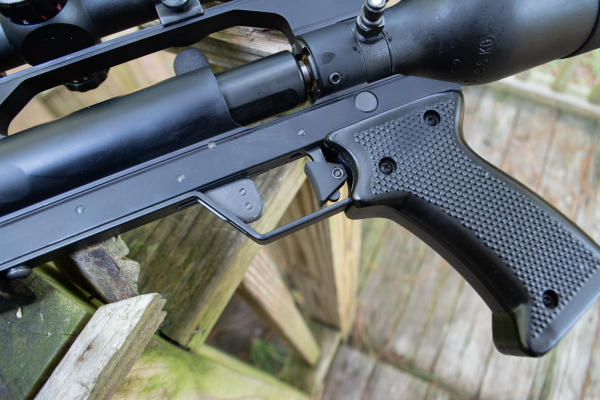
Push the trigger guard safety forward to fire.
This rifle may be a keeper. It shoots well, I love the trigger, and it’s quiet. I also like the .25 caliber chambering in an air rifle. It’s a good balance of power and capacity regarding shots per fill. The big bores are undoubtedly fun and have their place, but it’s always nice to get more than a handful of useful shots per charge. If I ever decide to enlist in the new United States Space Force, I’ll be sure to ask if this will be my issued rifle. Seems appropriate.
Technical Specifications:
MSRP: $814.95
-- Tom McHale